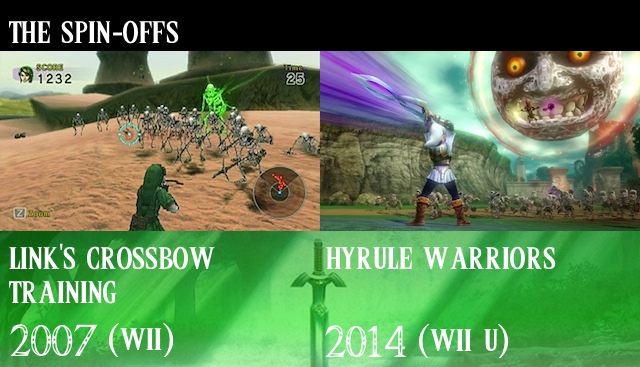
Part five of our Legend of Zelda retrospective is primed and ready for your reading enjoyment! In the last year, Nintendo has brought us yet more Zelda goodness, and the future continues to look bright for the venerable franchise. Along with a few more surprises, we close out our look at the Legend of Zelda with a bang!

Surprisingly, Nintendo has never dabbled much in spinning-off Zelda into other game series. These two titles, Link’s Crossbow Training and Hyrule Warriors, are the lone expansions to the Zelda franchise so far (well, these and the quartet of Tingle games North Americans never got to play). The former was a lot more fun than it had any right to be as a budget-priced pack-in game for the Wii Zapper peripheral. In Link’s Crossbow Training, player’s guided the nominal hero through first- and third-person shooting gameplay, with some segments on-rails and others more free-roaming. Hyrule Warriors was much more ambitious, taking the heroes and villains of the Zelda universe and mixing them with the gameplay of Koei Tecmo’s Dynasty Warriors series. It was a polished brawler whose development team just seemed to “get” what fans wanted to see from the Zelda characters in a 3D action game like this. The action was thrilling and over-the-top in the way that the best Dynasty Warriors games are, and gave fans hope that Nintendo would continue to expand the franchise in quality ways like this.

When Ocarina of Time 3D dropped, the number one question on the mind of many a Zelda fan was, “When do we get Majora’s Mask 3D?” A fair question, as the thought of only remaking one of the two brilliant Nintendo 64 Zelda games was almost unbearable (sadly, most people could totally see Nintendo leaving fans hanging like that, too). Majora’s Mask 3D just had to become a reality, and in 2015 it did. Where Ocarina of Time 3D only made a handful of small tweaks, though, this particular remake was more ambitious. The gameplay was essentially untouched, but the save system was overhauled (for a third time, actually; the original Japanese version of Majora’s Mask on N64 didn’t even have Owl Statues), with additional save points incorporated and some rearranged in order to make the game more player-friendly. Boss battles were also tweaked in order to make the weak points of the big baddies better understood. The game also took advantage of New Nintendo 3DS’s C-Stick, allowing for full 360 degree camera control that wasn’t available on standard 3DS systems. Like Ocarina of Time 3D, Majora’s Mask 3D also offered stunning new graphics that rounded out one superb package of a game.

Tri Force Heroes has been polarizing to Zelda fans. On the one hand, there are those who have been thrilled by the game’s unique three-person multiplayer antics, which can be experienced both locally and online. On the other hand, there are fans who are completely unimpressed with said multiplayer modes, because they prefer a totally single-player Zelda game. Though Tri Force Heroes can be played alone, manually controlling the other two Links on the screen can tend to be more of a burden than it was when simultaneously handling three other heroes in Four Swords Adventures. Still, there’s no denying how sidesplittingly hilarious the game’s setup is, with a fashion-obsessed kingdom in need of saving and the ability to dress Link in some truly funny (and sometimes even cool) costumes. Built using the same game engine as A Link Between Worlds, Tri Force Heroes is also one pretty title to behold, too. Love it or hate it, Tri Force Heroes can’t be accused of resting on the series’ laurels, as it boldly attempted to break from tradition with its multiplayer-focused quest.

In case anyone was worried as they reached the end of our retrospective, there is no end to the Zelda story. With Twilight Princess HD, Hyrule Warriors Legends, and the untitled Legend of Zelda for Wii U all heading to fans this year, there is plenty more to see from Nintendo’s elfin heroes. If the past thirty years have been any indication, Nintendo isn’t anywhere near close to running out of ways to innovate and entertain with the Zelda franchise. If anything, the company continues to demonstrate that, with each subsequent Zelda title, it’s more than capable of taking what fans love about the series and distilling it into increasingly more satisfying doses every time.
What is it about the adventures of Link, Zelda, and Ganon that’s just so captivating? For this writer, at least, it’s the joy of venturing into the unknown each time out, wondering where the story will lead me, and what new thrills Nintendo has concocted to blow my socks off. Zelda almost never disappoints, and even the games that I’m not excited for before launch always have some redeeming trait that ends up hooking me. I sincerely hope that these first three decades are followed by another three, and another three after that, and that generations of people will continue to latch onto the Legend of Zelda for being the wonderful piece of entertainment, storytelling, and art that it is.
With that, dear readers, Nintendojo’s Zelda retrospective has come to an end. What are your thoughts on the past, present, and future of the Legend of Zelda? Share with us in the comments!




 ShareThis
ShareThis





